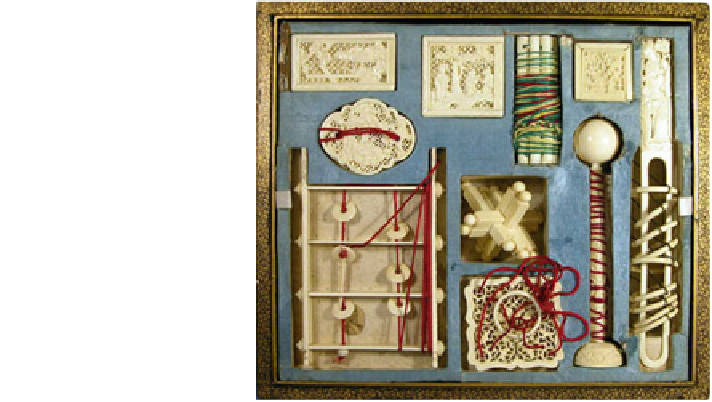Information Technology Reference
In-Depth Information
Fig. 6.6 A set of puzzles
from a ''Sunday box'',
designed for play (Copyright
2006 James Dalgety,
Hordern-Dalgety Collection.
Used with permission)
6.3 Problem Solving
Figure
6.6
shows a set of puzzles. Solving the problem of how to complete the
puzzles can be great fun. This general notion of problem solving also applies when
users try to perform tasks using systems in a particular context.
Problem solving essentially involves working out how to get from the current
state of affairs to the goal that you are trying to achieve by taking appropriate
actions. More formally, this can be described as applying operators to states to
reach a goal. Problem solving is often studied by looking at how people solve
puzzles, because the movement from one state to the next, and eventually to the
goal, can be directly observed.
In the Tower of Hanoi, shown in Fig.
6.7
, the goal is to move all the disks from
the left hand post to the right hand post. There are several constraints. The disks
can only be moved one at a time. The discs have to go on a post, and a disc cannot
be placed on top of a smaller disk.
The first decision is therefore where to move the smallest disk? It can be moved
to the middle or to the right post. The second decision is which disk to move, the
smallest (probably not, but you could), and if you move the second smallest disk,
there is only one post you can move it to. You continue in this way until all of the
discs in the tower have been moved to another post. Although there are several
ways to think about how to solve this puzzle, and several ways to solve it, there is
only one correct minimal path.
The Tower of Hanoi has been used for a long time as a useful illustration of
problem solving. Because it is a relatively simple, clear, but non-trivial problem, it
has been used to study problem solving. There is a clear starting state and a clear
goal state; the operations (operators) that can be applied are fairly evident and easy

Search WWH ::

Custom Search